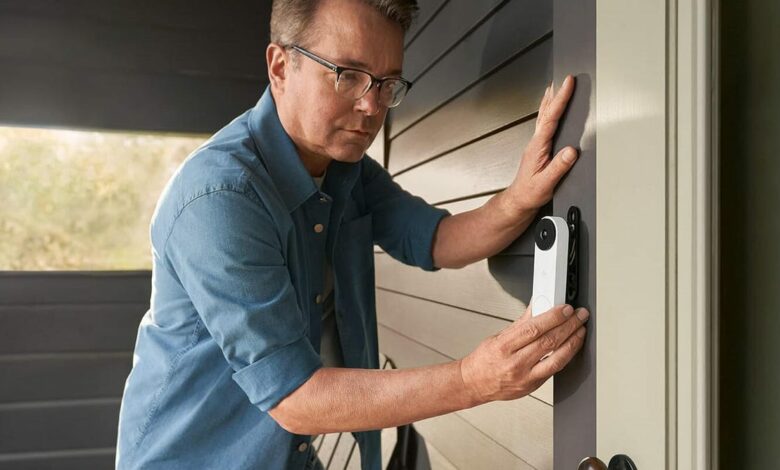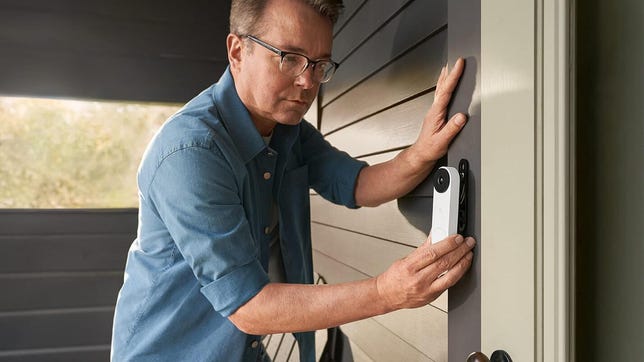Brief review Nest Doorbell 2nd generation: useful features, simple design



Plus points
- High-quality audio and video
- Many customizable settings
- Free cloud storage for up to three hours
- Compatible with Google Assistant and Alexa
- Excellent object recognition
- Both the battery and wired models work well
Disadvantages
- Recorded events are automatically deleted after 3 hours
- Somewhat limited field of view
As we head into the holidays, it’s a good time to think about beefing up your home security with a video doorbell. You can keep an eye on your package delivery when you order gifts online or receive them in the mail, and keep an eye on your home while you’re away. The second generation Nest Doorbell is an option to consider.
Google has built on the design and features of its battery-powered Nest Doorbell to create a second-generation doorbell. Now the wired and wireless versions of the doorbell are pretty much the same, except the battery model gives you a lot of extra placement options. We tested both models and there’s a lot to like, especially when it comes to the super smart technology that Nest offers for free with purchase.
The second generation Nest Doorbell isn’t entirely perfect. The free video storage is useful, but is limited to a three-hour period to take action. Not everyone likes to carry the battery version of the doorbell inside every time it needs to be charged (about every three months or so). Let’s take a look at all the details.
Even with a few imperfections, the new $180 wired Nest Doorbell is a decent value. It’s not the cheapest video doorbell you can find; for example, older models from Arlo and Wyze are cheaper. But if you prefer Google devices and are looking for an easy-to-use, feature-packed home security upgrade for your porch, you’ll likely find the second-generation Nest Doorbell worth the cost. And if you’re okay with the 3 hours of cloud storage and don’t need the more advanced AI features, you can also save on a subscription. That’s why this is one of my favorite recommendations for first-time home security investors.
From a design perspective, we found that the wired and wireless versions of the doorbells tested were virtually the same, with a few differences. The wired doorbell must be connected to the place where your old doorbell was, so you can no longer place it. The battery model does not have this limitation, but is a bit bulkier with a total of 6.3 inches. Otherwise the two function the same.
Video and audio quality
Google’s Home app makes managing the Nest Doorbell easy, especially if you have other Home devices.
With a resolution of 1,280 x 960 pixels, HDR and clear night vision, the video quality of the second generation Nest Doorbell is as good as any. I could see everything in great detail from my porch and beyond at virtually any time of day. Colors are bright and vibrant when there is light outside, and shapes and movements are noticeable at night, even when no lights are on.
As we found with the previous generation Nest Doorbell, I found the 145-degree diagonal field of view and 3:4 ratio to be somewhat limited, at least horizontally. In our wired test, we had to place the doorbell more than 6 inches away from the door, which means it can be difficult to capture all the space in the porch and the people or packages there. The battery version has an advantage here as we were able to install it much closer to the door for a full view.
Google also seems to be aware of this little problem. To solve this problem, the package comes with a 20-degree wedge mount to better direct the doorbell and camera towards the door. After placing the wedge I had a sufficient view of everything in front of the door.
As for the sound quality, I could clearly hear someone talking or the thud of a package being delivered, and the sound quality wasn’t disrupted too much by background noise like the wind or a passing car. Likewise, everyone on the porch had no problem hearing me and communicating with me via the two-way audio. The Google Home app also offers quick responses for an AI response without starting a conversation.
About those smart warnings and recorded history
You can customize the second-generation Nest Doorbell to watch for people, packages, animals, vehicles, or any movement, limiting recordings and notifications to only the events you want to see. I started by selecting all alert options, but after a day of notifications I switched to just people and packages.
The smart notifications were certainly smarter than I expected. For example, the ‘People’ alert setting naturally sent notifications and recorded video when someone walked to the door, but also when someone walked on the sidewalk in front of my house. It wouldn’t bother me if I got notified when my neighbors across the street were getting in their cars or playing in the yard, even though they were certainly visible in the camera feed. The “Packages” setting showed off similar smart features, sending a notification not only when a package was delivered, but also when someone picked it up, accurately every time.
By default, Nest Doorbell 2nd generation is set to automatically record video of all your selected events and store them for up to 3 hours. Audio recording is not enabled by default, but you can activate it under the device settings if you want to record audio in addition to video. If you don’t want or need either, simply disable event recording in the device settings.
The free recording feature is nice, but as we previously noted with the first-generation Nest Doorbell, it doesn’t do much good after that 3-hour window. If your doorbell recorded activity at 3 a.m., but you didn’t wake up and see the notification until 7 a.m., then that recording has already been deleted.
For 24/7 recording and longer duration of saved activity, you need a Nest-conscious subscription. Starting at $8 per month, Nest Aware includes 30 days of event history storage. For double the subscription cost, you can upgrade to the Nest Aware Pro plan and get 10 days of 24/7 recording (here the wired version of the doorbell shines because it doesn’t drain the battery) and 60 days of event history storage.
Nest plans also add even more AI tech, most notably the ability to add profiles of familiar faces for people you want the doorbell to recognize (Google is one of the few brands to offer this somewhat controversial capability), and more advanced sound detection, such as nearby glass breaking.
Design and installation
Google’s second-generation doorbell opts for a more muted design with soft colors and rounded edges, focusing on a large doorbell button. Even the battery model of the doorbell is very compact compared to the competition’s options and feels much sturdier than the latest doorbells from brands like Ring. That calm appearance is not for everyone. I chose ash, which suits my home well, but I would compare the look to that of the keychain pad at the pool in my neighborhood. Something less utilitarian might have been better suited for a $180 device.
The Nest Doorbell is available in four colors: snow, linen, ash and ivy.
Another thing to think about: Do you want your video doorbell to stand out? Granted, a good smart device should complement your home and go virtually unnoticed, except perhaps if the device is partly for the security of your home. I would argue that a conspicuous video doorbell could be a more recognizable and effective deterrent to potential porch pirates or intruders than a discreet doorbell.
Fortunately, installation turned out to be quick and easy. The Google Home app walked me through a series of easy-to-follow, step-by-step instructions from start to finish. Other than spending a few minutes figuring out which switch in the electrical panel controlled the doorbell, the only problem I encountered was the doorbell wiring.
The wiring is a few inches longer than I needed and connects to the doorbell wiring via two somewhat bulky connectors, rather than just twisting the wires together. I ended up having to put the excess wiring and connectors into the hole for the doorbell wiring, so some additional work may be required.
The battery model doesn’t have these issues, and when a spot on the door trim was picked out, I found the installation was complete in minutes after some quick drilling. Since both models cost the same, it’s worth considering the battery model if you don’t fancy wiring at all. Note that your old doorbell won’t work on the wireless model, although you can customize the alerts and sounds you receive through the Google Home app.
In summary
Whether you like the design or not, there’s no denying that the features and smart technology of the second-generation Nest Doorbell (wired or battery-powered) are impressive. It’s not the cheapest video doorbell on the market, but I’d say the video and audio quality, customizable alert and ringer settings, and compatibility with Google Assistant and Alexa devices more than justify the cost.




